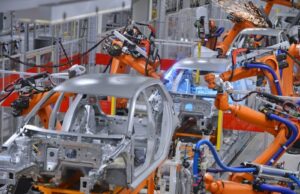The automotive industry has been at the forefront of manufacturing technology since Henry Ford introduced the assembly line to the world in the early 1900s.
The increased complexity of today’s cars increases the likelihood of production errors. Manufacturers cannot afford these errors on a market that is so competitive. The manufacturers must meet the NHTSA’s (National Highway Traffic Safety Commission) standards and also the current trends of the consumer market. In order to achieve both, industrial robotics and computer vision are growing rapidly in the automotive industry.

Industrial Robotics And Machine Vision In The Auto Industry
Machine vision is widely used within the automotive industry for a wide range of applications, primarily inspections and robot guidance. Industrial robotics can use embedded vision sensors to find objects in 2- or 3-dimensional space and adjust the path of the object. Machine vision is used to guide the robots to achieve greater accuracy when performing critical tasks such as picking up parts from racks, bins and assembling them.
Manufacturers are able to save time and improve accuracy, while also increasing safety in their factories. In the auto industry, industrial robotics and vision technology are used everywhere.
In fact, today’s automotive inspection applications use a wide range of machine vision technologies. These include 3D imaging and barcode reading as well as multi-camera, smart, and line scan systems.
A growing trend is towards 3D machine vision for manufacturing. Up until now, the majority of visual guidance technologies for manufacturing robots have been 2D. However, there is a growing trend towards 3D imaging and machine vision.
The 3D technology is useful in many inspection applications. Some of these are:
- Advanced Automation
- Lot tracking
- Quality control
- Component traceability
- Gauging critical dimensions
- Robot guidance
- Compliance with DOT
A 3D vision system will allow any industrial robotics system to function accurately and provide real-time information. It can target and grab an object on a production line, whether it’s flat on a belt conveyor, hanging or upright. The robot can now be more independent and versatile with 3D vision.
In order to continue to meet this growing demand, developers have developed sophisticated systems consisting of many cameras mounted on an fixed frame. These cameras are positioned in various positions to capture different images of each individual part or product for quality assurance.
These vision inspection stations are not only highly effective in detecting defects on production lines, but they can also be done in seconds. Today’s automakers demand a more flexible vision inspection process due to the growing number of product variations.
Vision systems are becoming more sophisticated as a result of the increasing demands in the automotive industry. Precision lenses in the systems will also need to become more precise as they advance. We meet these demands at SUPERIOR Optics. Our design team can create a lens to your exact specifications or we have a wide range of lenses on hand. We look forward working with you.




